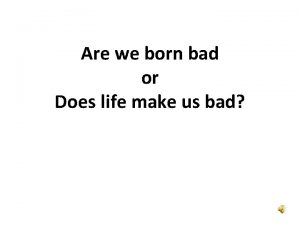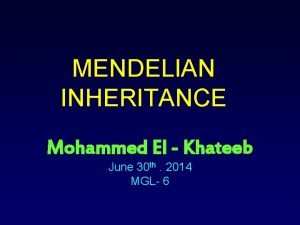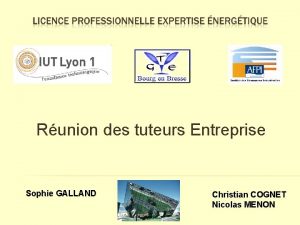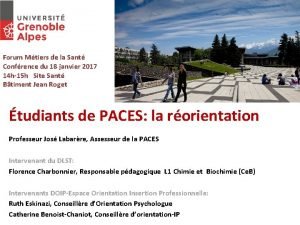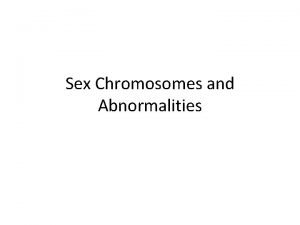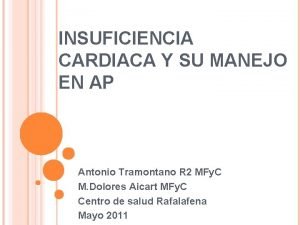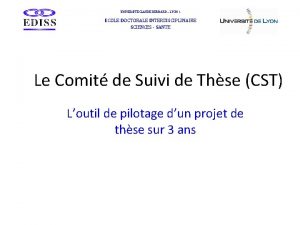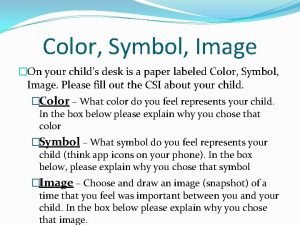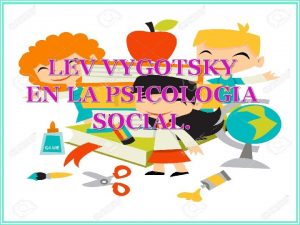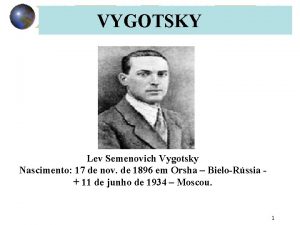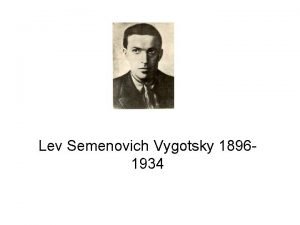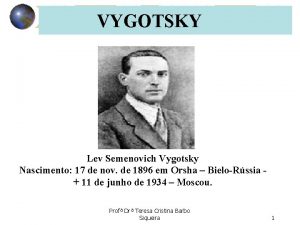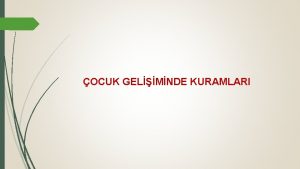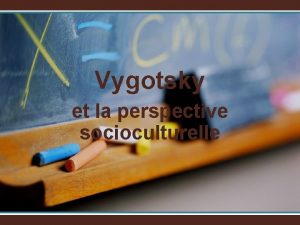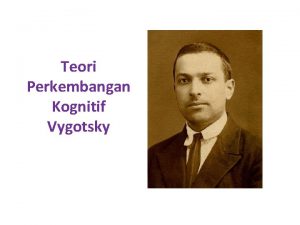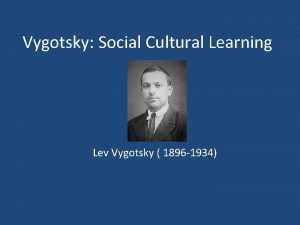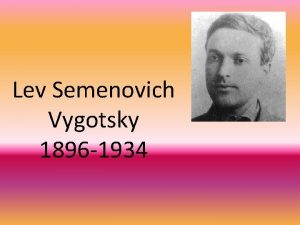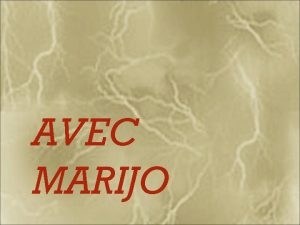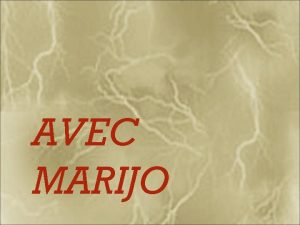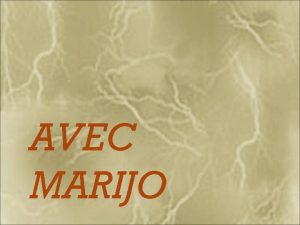Mrs K L S Vygotsky Stephanie Lyon Moira



























- Slides: 27

Mrs. K L. S. Vygotsky Stephanie Lyon & Moira Debbs

Background ● ● ● Birth: 1896 Death: 1934 Lev Semenovitch Vygotsky was a Marxist His life was cut short by Tuberculosis In 1936 the Soviet Government banned his work ○ This lasted until 1956 ● Vygotsky believed that one could only understand humans in the socialhistorical environment

Nature vs. Nurture? Vygotsky believed that there was an interplay between the two lines of development The natural line emerges from within the person The social-historical line influences the child from without Elementary Processes (Biological) Higher Processes (Sociocultural) Vygotsky “Sign-using activity in children is neither simply invented nor passed down by adults” (Vygotsky, Mind in Society, 46)

Key Terms Psychological signs: Internal activities aimed at mastering one’s self. Very similar to Piaget’s Schema such as speech and writing. Psychological tools: Something that is externally oriented that serves as a conductor of human influence on the object of an activity. Zones of Proximal Development: The specific periods of a child’s development at which certain abilities and traits develop using aids. Meditated memory function: The point of higher functioning memory; when one can use aids to help themselves. Unmediated memory function: A lower type of memory function. Is often seen in children who are still developing. Cognitive Development: the thought process and how memories and life skills form and change from childhood to adulthood.

Key Terms continued Direct Learning: When a child interact directly with the environment. Done primarily with observational learning, trial and error, etc. Mediated Learning: When adults or more competent peers place themselves between the environment and the child.

Forbidden Color Task ● Conducted by Leontiev in Vygotsky’s lab ● Participants (ages 5 -27) were asked 3 -4 groups of 18 questions, 7 of which had to do with colors. ● After each test, a new “rule” was applied. ● Results were analyzed on the number of errors. ● This was done to look at mediated memory development.

Leontiev’s Study Results Age Number of Subjects Errors Average Task 2 Errors Average Task 3 Difference Between tests 5 -6 7 3. 9 3. 6 0. 3 8 -9 7 3. 3 1. 5 1. 8 10 -13 8 3. 1 0. 3 2. 8 20 -27 8 1. 4 0. 6 0. 8

Conclusions from Study ● Children in the first age group were unable to fully grasp the use of the aid of the cards. Even after having the cards explained to them, they still could not use the cards as an aid; the use of the cards even seemed to hinder them. ● The children in the second age group responded much like the first, unable to grasp how to use the color aids to help them fully. They often just looked at the cards and would interact with them occasionally. ● The third group was able to use the cards, but would forget about them, indicating some mistakes ● The final group, the oldest age, was able to use the cards to their advantage, often moving them around or placing them out of site so that they did not use the color more than once or not even using them all.

Stages Developed from the Study 1. Preschool Age a. Child is not capable of using the cards to aid in their behavior (cards still act as stimuli) 2. Introduction of cards raises effectiveness of the child’s activity 3. Interalization a. The external sign that school age children used has been transformed into an internal sign. Experiment showed how external forms of mediated behavior develop

Process of Internalization 1. An operation that initially represents an external activity is reconstituted and begins to occur internally 2. An interpersonal process is transformed into an intrapersonal one 3. The transformation of an interpersonal process into an intrapersonal one is the result of a long series of developmental events -Vygotsky, Mind in Society, 56 -57

How does a tool become a sign? Meredith Whittaker used a map of D. C. to understand Vygotsky’s Theory. The map brought meaning to the world around her and was initially used as a tool for navigation. Later the map became a sign. She added meaning to the particular train lines and stops based upon her experiences.

Our Study Our Goal was to recreate Vygotsky’s and Leontiev’s study. We did this by testing children and young adults within the same age groups that they did, and we based our questions off of their original questions. Some questions were reworded, and some questions were altered slightly to fit with time today.

Guiding Questions 1. Are younger students more likely to use unmediated memory functions (elementary mental functions -- no tools) and make more errors than older students when asked to play memory games? 2. Are older students likely to use mediated memory function (higher mental function with tools) and make no or very few errors when asked to play memory games? 3. Will younger engage in mediated memory functioning (higher mental functioning that uses signs) when tools are offered?

Hypothesis We believed that we will see similar results as shown in Leontiev’s Study. Younger children will be unable to use the cards effectively, Older children will make proper use of the cards to aid in memory recall, and young adults will not use the cards because the memory aiding process will have already been internalized.

Research Methods ● We interviewed students from a private elementary/middle school and from a private university. ● Verbal interviews were given with the participants on either of the campuses, and with the young adults some interviews were given within their homes.

Setting and Assumptions ● The study was done, for the school age children, in the common area between their classrooms. There was often noise and distractions of other teachers and children. ○ If we could have been in a quiet setting, the participants might have been able to focus more. ● The study was done, for group four (the oldest group), generally in their own home. ○ They were probably more comfortable and relaxed in an environment that they felt they had control of.

Limitations ● Limited number of children available. We did not have the same number of participants as Vygotsky did. ● Unclear rules on what all “errors” were. We only knew to categorize “errors” as the use of the forbidden colors or the repetition of a color. ● We did not have a neutral testing environment that all participants were tested in. ● We divided the participants, making the way we asked questions different. Our facial cues and responses were also not the same and each child might have felt differently and responded differently to us. ● We were not able record our participants with audio (technical issues) so we weren't able to go back over the data in this manner.

Scoring and Evaluation ● Point every time one of the forbidden colors is said ● Point every time the same color is said ● Notes on when synonym of colors were used, the “I don’t know” answer was given, or showing the cards were done in place of saying the color

Pre-K Ages 5 -6 Participant (Age) (Sex) Trial Two Errors Trial Three Errors Trial Four Errors 1 (5) (F) 4 4 3 2 (6) (M) 4 1 (6) 2(7) 3 (5) (F) 1 2 4 4 (6) (M) 4 3 2 Average Errors 3. 25 3. 75 4

2 nd and 3 rd Graders Ages 7 -9 Participant (Age) (Sex) Trial Two Errors Trial Three Errors Trial Four Errors 1 (7)( (F) 3 3 1 2 (8) (F) 2 2 2 3 (9) (M) 4 4 5 4 (9) (F) 2 3 3 Average Errors 2. 75 3 2. 75

6 th Graders Ages 11 Participant (Age) (Sex) Trial Two Errors Trial Three Errors Trial Four Errors 1 (11) (F) 3 3 1 2 (11) (F) 2 6 2 3 (11) (M) 3 3 2 Average Errors 2. 67 4 1. 67

Young Adults Ages 20 - 26 Participant (Age) (Sex) Trial Two Errors Trial Three Errors Trial Four Errors 1 (21) (F) 2 0 N/A 2 (20) (F) 0 1 0 3 (26) (M) 1 0 0 Average Errors 1 0. 33 0

Debbs’ & Lyon’s Study Age Number of Subjects Errors Average Task 2 Errors Average Task 3 Errors Average Task 4 Difference Between Task 2 & 3 Difference Between Task 2 & 4 Difference Between Task 3 & 4 5 -6 4 3. 25 3. 75 4 . 75 . 25 7 -9 4 2. 75 3 2. 75 . 25 0 . 25 11 3 2. 67 4 1. 67 1. 33 1 2. 33 20 -26 3 1 0. 33 0 0. 67 1 0. 33

Our Results compared to Leontiev’s

Continued. . .

Conclusions Our results slightly differed from Leontiev’s. The youngest and oldest age groups’ results remained consistent from Leontiev’s study, but the middle age group (11 year olds), in which we anticipated use of the cards to aid memory recall, differed greatly. The only improvement was seen in trial four, but the cards were still not used by any of the participants in this trial. These difference might have occured because of the setting in which the interviews were taken, and the extreme outlier skewed our results.

What we would do differently next time. . . ● Have the same person interview each child while the other records observations and answers. ● Have a consistent setting in which the interviews take place to limit other distractions.
 Celia moiseevna vigodskaya
Celia moiseevna vigodskaya Mit web moira
Mit web moira Moira fischbacher-smith
Moira fischbacher-smith Moira hindley
Moira hindley Moira king
Moira king Moira savage
Moira savage They are mrs garcia and mrs castro
They are mrs garcia and mrs castro They are mrs garcia and mrs castro
They are mrs garcia and mrs castro Mrs. darling was ___________ of mrs. s.
Mrs. darling was ___________ of mrs. s. Lyon hypothesis
Lyon hypothesis Webconvergence lyon
Webconvergence lyon Christian cognet
Christian cognet En covoit grand lyon
En covoit grand lyon Ciell2 lyon
Ciell2 lyon Hoshin kanri exemple
Hoshin kanri exemple Cio lyon 8
Cio lyon 8 Tobi lyon
Tobi lyon Dr milena lyon
Dr milena lyon Wendy lyon solicitor
Wendy lyon solicitor Sex xxx nn
Sex xxx nn Astronomical clock lyon france
Astronomical clock lyon france Criterios framingham
Criterios framingham Ecole doctorale chimie lyon
Ecole doctorale chimie lyon Institut national des sciences appliquées founded
Institut national des sciences appliquées founded Quartier aligre gare de lyon
Quartier aligre gare de lyon South lyon typing club
South lyon typing club Contract
Contract Claroline université lyon 1
Claroline université lyon 1



